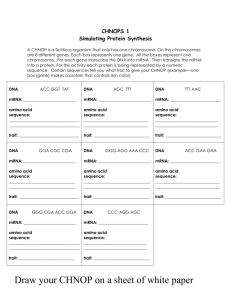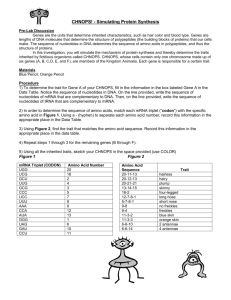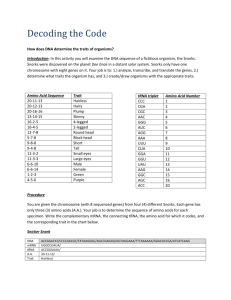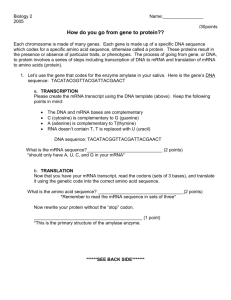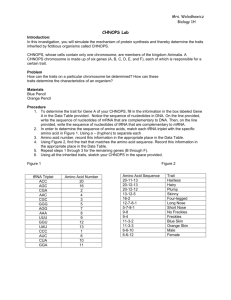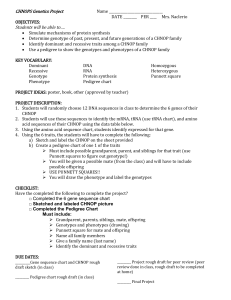Simulating Protein Synthesis
advertisement
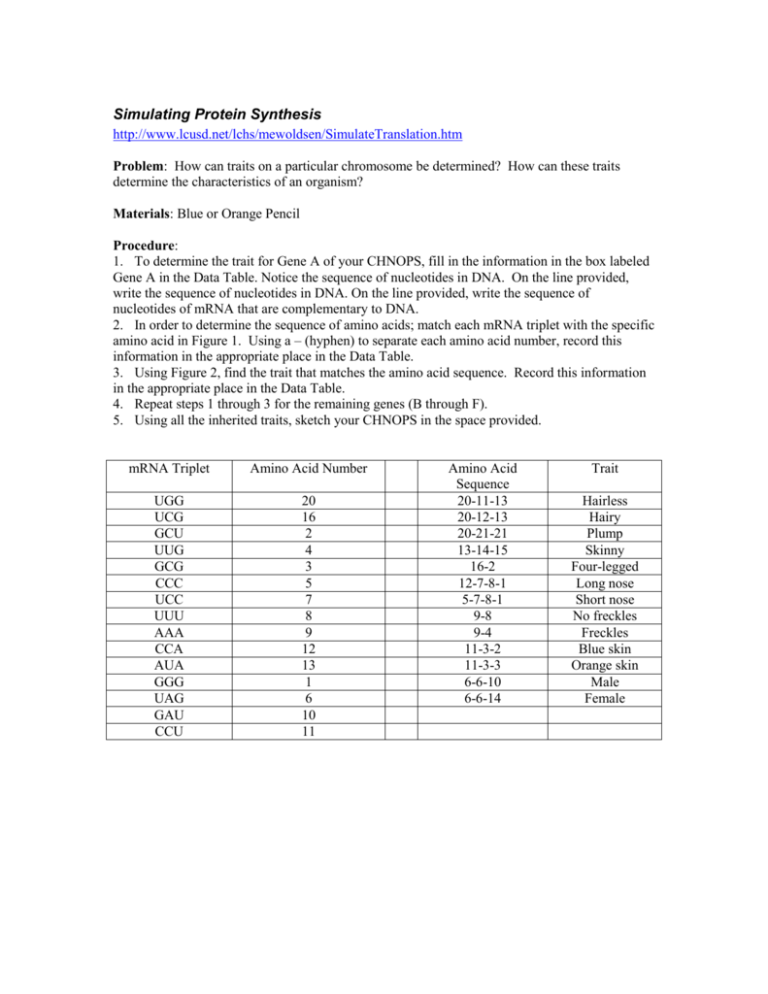
Simulating Protein Synthesis http://www.lcusd.net/lchs/mewoldsen/SimulateTranslation.htm Problem: How can traits on a particular chromosome be determined? How can these traits determine the characteristics of an organism? Materials: Blue or Orange Pencil Procedure: 1. To determine the trait for Gene A of your CHNOPS, fill in the information in the box labeled Gene A in the Data Table. Notice the sequence of nucleotides in DNA. On the line provided, write the sequence of nucleotides in DNA. On the line provided, write the sequence of nucleotides of mRNA that are complementary to DNA. 2. In order to determine the sequence of amino acids; match each mRNA triplet with the specific amino acid in Figure 1. Using a – (hyphen) to separate each amino acid number, record this information in the appropriate place in the Data Table. 3. Using Figure 2, find the trait that matches the amino acid sequence. Record this information in the appropriate place in the Data Table. 4. Repeat steps 1 through 3 for the remaining genes (B through F). 5. Using all the inherited traits, sketch your CHNOPS in the space provided. mRNA Triplet Amino Acid Number UGG UCG GCU UUG GCG CCC UCC UUU AAA CCA AUA GGG UAG GAU CCU 20 16 2 4 3 5 7 8 9 12 13 1 6 10 11 Amino Acid Sequence 20-11-13 20-12-13 20-21-21 13-14-15 16-2 12-7-8-1 5-7-8-1 9-8 9-4 11-3-2 11-3-3 6-6-10 6-6-14 Trait Hairless Hairy Plump Skinny Four-legged Long nose Short nose No freckles Freckles Blue skin Orange skin Male Female Observations: Gene A Gene B DNA TAT ACC GGT mRNA ____ ____ ____ Amino Acid Sequence ____ ____ ____ Trait Gene D GGA mRNA ____ ____ ____ Amino Acid Sequence ____ ____ ____ Drawing: DNA AGC CGA DNA TTT AAC mRNA ____ ____ mRNA ____ ____ Amino Acid Sequence ____ ____ Amino Acid Sequence ____ ____ Trait Trait Gene E DNA CGA Trait Gene C CGC DNA CCC Gene F DNA CTA ATC ATC mRNA ____ ____ ____ ____ mRNA ____ ____ ____ AA Seq ____ Amino Acid Sequence ____ ____ ____ Trait GGG AGG AAA ____ ____ ____ Trait Analysis: 1. Distinguish between translation and transcription. 2. What is the specific site for transcription and translation in the cell? 3. How many tRNA nucleotides form an anticodon that will attach to the mRNA codon? 4. Suppose you knew the makeup of specific proteins in a cell. How would you determine the particular DNA code that coded for them? 5. How could one change in a DNA nucleotide alter the formation of the translated protein? (an example would be the difference between normal and sickle-cell hemoglobin.) Conclusion: Describe the entire process of protein synthesis, including locations, steps, etc.




